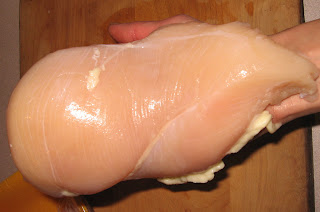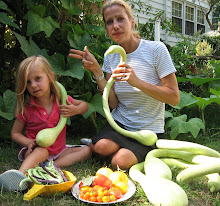
A two-pound single chicken breast.
Really. This thing weighed close to 2 lbs. if it weighed an ounce. I try not to buy a lot of supermarket meat. I haven’t bought industrial beef in years, and try to limit other types of meat. But in all practicality, I have to feed my family. When a reasonably sized package turns up during a sale, I consider purchasing it. It’s rare to find anything other than a double-pallet-sized Styrofoam boat of meat any more, especially when the cut is on sale. This $6 package weighed about three pounds. I counted five breasts glinting through the plastic wrap. Perfect: grill two small ones tonight, then freeze the other three, cut and divided into scant one-pound portions for future use.
 This giant breast showed through the wrap just like the others, a squeezed-in triangular sliver peeking out amidst the other four. When I opened the package to divide the contents for freezing, I was completely dumbfounded as to how I was going to divvy up the contents. Then I was just dumbfounded. How did this chicken walk, much less breathe with two, count ‘em, two breasts this size? And how did they grow this big, that fast? Supermarket chickens live an average of six or seven weeks before slaughter. That’s between 40 to 50 days. By law, they’re not given antibiotics or hormones. Hell, they don’t live long enough to need them.
This giant breast showed through the wrap just like the others, a squeezed-in triangular sliver peeking out amidst the other four. When I opened the package to divide the contents for freezing, I was completely dumbfounded as to how I was going to divvy up the contents. Then I was just dumbfounded. How did this chicken walk, much less breathe with two, count ‘em, two breasts this size? And how did they grow this big, that fast? Supermarket chickens live an average of six or seven weeks before slaughter. That’s between 40 to 50 days. By law, they’re not given antibiotics or hormones. Hell, they don’t live long enough to need them.Now, I’ve purchased the ol’ reliable Perdue Oven Stuffer Roasters – remember, I’m a believer in a well-stocked freezer. Plus, they’re great for extended family dinners or for a week’s worth of leftovers served six ways. I know the Oven Stuffers come from a different breed of bird, but they’ve been bred and are raised for the same qualities: large breasts, lots of meat, short lives before slaughter for lower feeding and housing costs to the farms.
I’ve never gotten a single breast or even a combined pair of breasts off of an Oven Stuffer that came close to the size of this monster.
And in the end, the chicken didn’t even have any flavor or texture. Yes, I used it that night. I had to cut it into pieces similar in size to each other for grilling then similar in size to the other four breasts I prepared for freezing. I did a simple marinade of fresh garlic, lemon juice, cracked black pepper and olive oil, tossed the pieces on my grill pan, then topped them with crunch of sea salt, a squeeze of lemon and a sprinkling of fresh chopped Italian parsley. Side dishes of my summer zucchini sautéed with sweet onion and corn kernels, and penne alia oglio rounded out the meal. I achieved nice grill marks on the meat, and this is usually a good, foolproof and tasty preparation, with leftovers sliced over a salad or tossed into the pasta the next night. However, there was no chicken flavor to be had and the mealy texture certainly didn’t help.
True, Birdzilla’s breast could have fed my family for a month. But I won’t be buying skinless boneless chicken breasts again any time soon.











